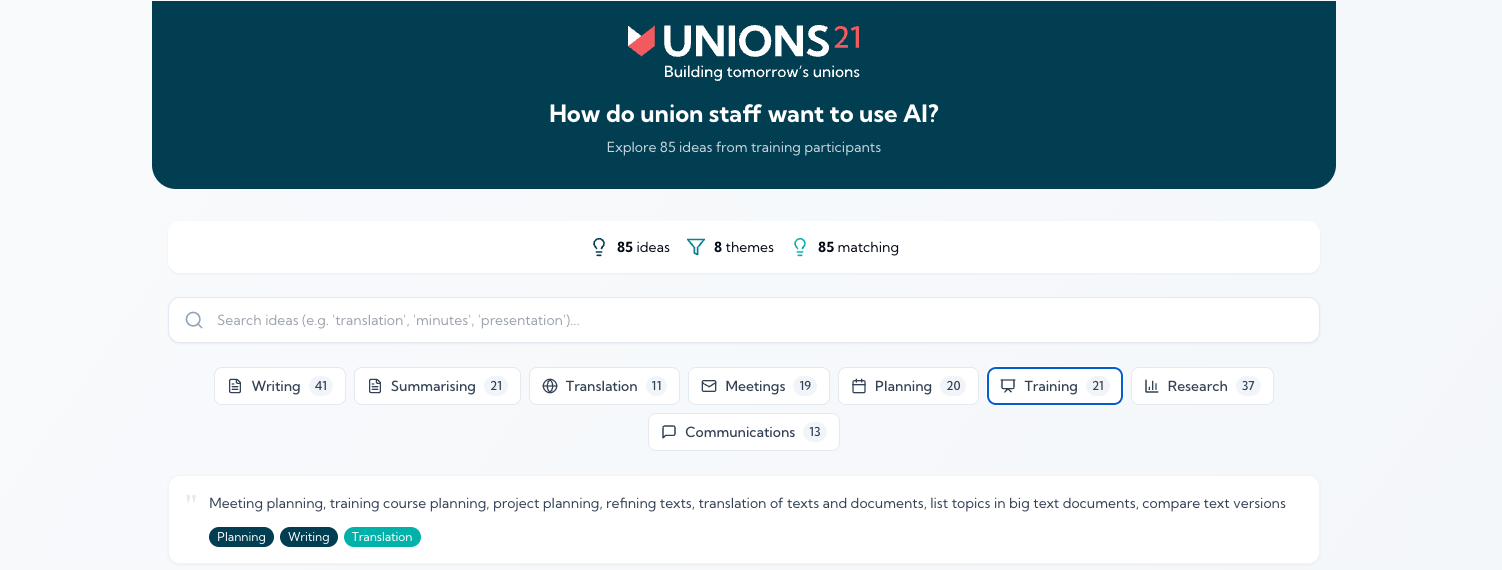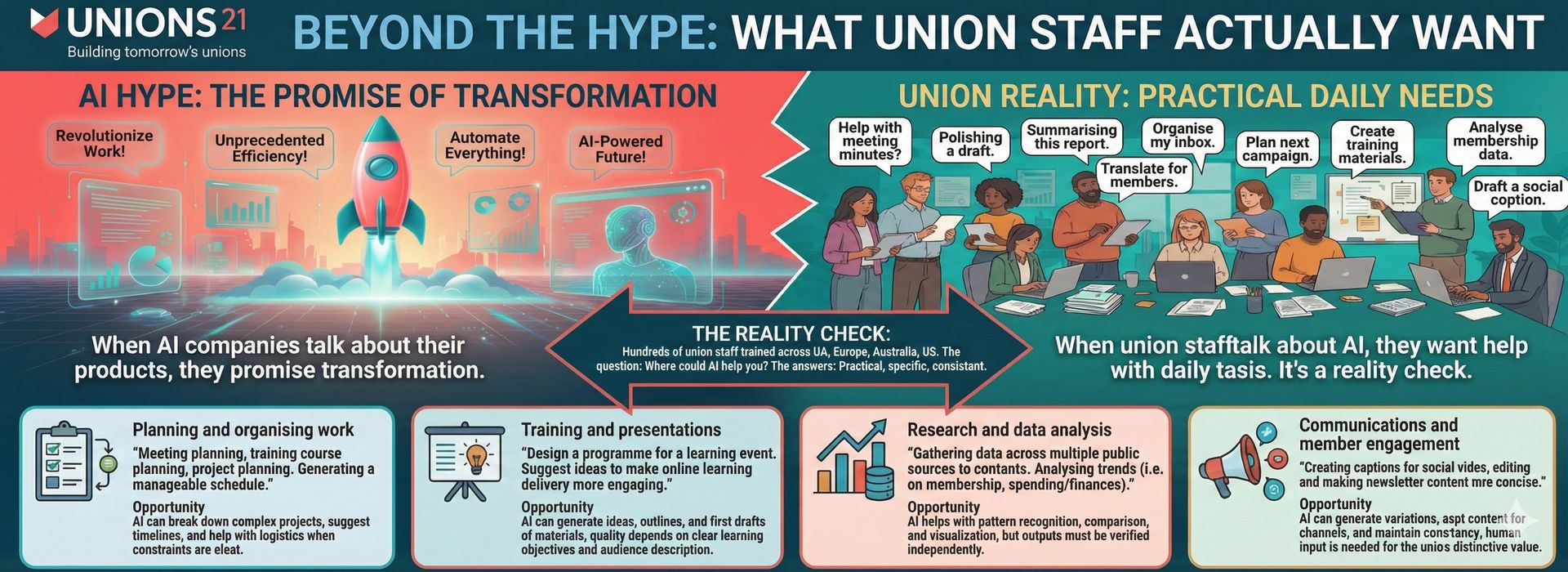When AI companies talk about their products, they promise transformation. When union staff talk about AI, they want help with meeting minutes.
That's not a criticism. In fact, I think we should be talking about transformation too. But it is a reality check. Over the past year, we've trained hundreds of union staff from across the UK, Europe, Australia, and the United States. As part of each workshop, we ask a simple question: Where could AI help you?
The answers are practical, specific, and grounded in the daily realities of union work. They're also surprisingly consistent across different unions, countries, and job roles.
Three things stand out from these responses:
Staff want AI for the mundane, not the meaningful
Almost no one asked AI to replace the core human work of unions - organising conversations, representing members, building solidarity. They want help with the administrative overhead that takes time away from that work-
The use cases are remarkably consistent
Whether we're talking to a comms officer in London or an organiser in Chicago, the same needs come up: summarising, translating, drafting, organising. This suggests there's real potential for shared learning across the movement.
Union staff are thinking carefully about what's appropriate
Many responses included caveats: "with human review", "for internal use", "low risk because I'll check it". Union staff aren't rushing blindly into AI… they're trying to find the right boundaries.
Three ways of showing the results
In keeping with our "show by doing" approach, we used three different AI tools to present this data - each with different strengths:
Claude interactive artifact
Claude's artifacts feature lets you build interactive tools that readers can explore themselves. I turned the raw responses into a filterable dashboard - click a theme, search for keywords, see what your peers are thinking.
Google “Nano Banana Pro”
Google's new image model (part of Google Gemini) can now render text accurately in graphics - something that was laughably bad just months ago. We used it to create an infographic summarising all eight themes.
And this article? Also drafted with AI assistance, then edited and verified by a human. Three tools, three approaches, same underlying data.
More than 500 union staff who have now been through one of the Unions 21 AI training courses.
This article is based on data from our Responsible AI Fundamentals workshops. If you want to develop your own skills in using AI effectively – and responsibly –our training courses can help.
This is an example of what our AI training is all about: knowing where and how AI can help union staff focus on what matters most: working with members and workers to build collective strength and improve conditions for all.
Think AI could support you in your work?
We have a few more spaces on courses for early 2025.
The themes: where union staff want AI to help
We've organised the responses into themes below. If you're wondering where to start with AI, this is a good map of where your peers are looking.
1. Writing and refining text
The most common request by far. Union staff produce enormous amounts of written content—and much of it follows recognisable patterns.
The opportunity: AI is genuinely strong at editing, restructuring, and polishing text. It can suggest clearer phrasing, adjust tone for different audiences, and help non-native speakers produce fluent content.
"Refining texts, polishing up drafts"
"Making texts more readable"
"Improving language, giving a better shape to texts"
"Imitating certain writing styles"
2. Summarising and extracting information
Union staff regularly face walls of text -reports, legislation, meeting transcripts, collective agreements - that need to be distilled into usable information.
The opportunity: This is one of AI's most reliable use cases. It can quickly identify key points, extract action items, and create summaries - though you'll always need to verify anything that matters.
"Summarising long reports and papers"
"Extracting information from a large base of articles and data"
"Summarising responses to a survey to give me an overview before I start fully analysing"
3. Translation and multilingual work
For unions operating across borders or serving diverse memberships, translation is a constant need.
The opportunity: AI translation has improved dramatically. For internal communications and first drafts, it's often good enough. For public-facing or legally significant content, human review remains essential.
"Translation of texts and documents"
"As a non-native English speaker, helping me polish up/edit text"
"Video translation"
4. Meeting and email management
The administrative burden of union work is real. Staff are drowning in emails, meetings, and the documentation that follows.
The opportunity: This is an area of active development. AI meeting transcription and summarisation is increasingly reliable. Email management tools are improving but still hit limitations.
"Minutes taking :) :) :) Would save time to focus on other matters"
"Help with my inbox after 2 weeks of annual leave"
"Organize received emails by topic and urgency"
"Sort email into folders and draft suggested replies for review"
"To find space in multiple agendas"
5. Planning and organising work
From project timelines to event logistics to personal task management, staff want help getting organised.
The opportunity: AI can help break down complex projects into steps, suggest timelines, and help you think through logistics. It works best when you can describe the constraints and context clearly.
"Planning projects - suggestions on steps and time needed to complete"
"Planning my travel"
"Generating a manageable schedule that is ADHD friendly"
"Detail out tasks for projects"
6. Training and presentations
Education officers, organisers, and anyone who delivers training sees potential in AI for course development.
The opportunity: AI can help generate ideas, create outlines, and develop first drafts of training materials. The quality depends heavily on how well you can describe your learning objectives and audience.
"Write a short paper on the opportunities and risks of AI in trade union learning"
"Design a programme for a learning event"
"Suggest ideas to make online learning delivery more engaging"
"Staff training on lone working risk assessments—help create presentation and summary materials"
"Formatting styles, such as making a document more neurodiversity friendly"
7. Research and data analysis
From membership trends to employer finances to policy briefings, union staff need to make sense of data.
The opportunity: AI can help with pattern recognition, data comparison, and generating visualisations. But it can also confidently produce wrong answers. For anything that matters, verify the outputs independently.
"Gathering data across multiple public sources to compare"
"Analysing trends (i.e. on membership, spending/finances)"
"Collecting data such as open rates, click-through rates about repeat types of communication broadcasts"
"Compare two separate spreadsheets... identify which preferred hotels also appear in the union hotel list"
8. Communications and member engagement
Comms teams and organisers want help reaching members more effectively.
The opportunity: AI can help generate variations, adapt content for different channels, and maintain consistent messaging. The risk is that AI-generated content can feel generic—your union's distinctive voice still needs human input.
"Creating captions for social videos, editing and making newsletter content more concise"
"Generating promotional text for upcoming webinars/courses"
"Generate better visualisations for a presentation"
Some notable specific ideas
Beyond the main themes, some responses stood out for their creativity or specificity:
For industrial work:
"Comparing CBA rules and regulations"
"My team looks at a lot a LOT of local union constitutions. I am very curious about looking at patterns across these documents"
"Language for contracts; understanding current dynamics in specific industries"
For organising:
"Bounce back ideas, I have used it in the past to practice structured organising conversations"
"Scenario planning to generate campaign possibilities to assist with strategy development"
For accessibility:
"Formatting styles, such as making a document more neurodiversity friendly"
"Generating a manageable schedule that is ADHD friendly"
The unexpected:
"To help pick songs that we'll use at the beginning of meetings that relate to that meeting!"
AI Transparency statement
This article was drafted using Claude.ai based on anonymised responses from Unions 21 training workshops. The interactive explorer was built using Claude's artifacts feature. The infographic was created using Google's Nano Banana Pro. All outputs were reviewed and edited by a human before publication.




